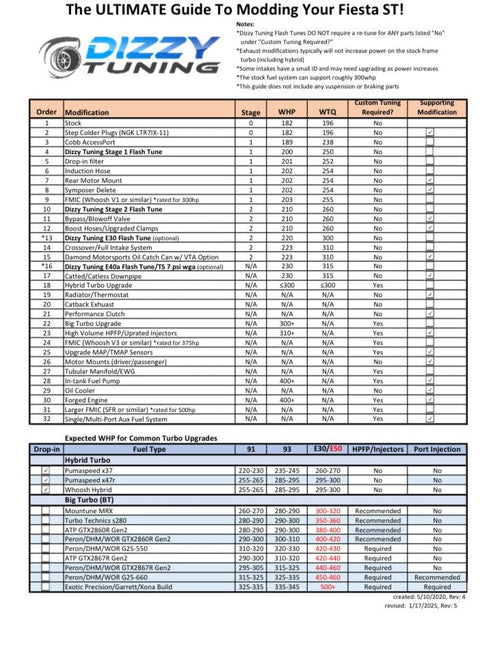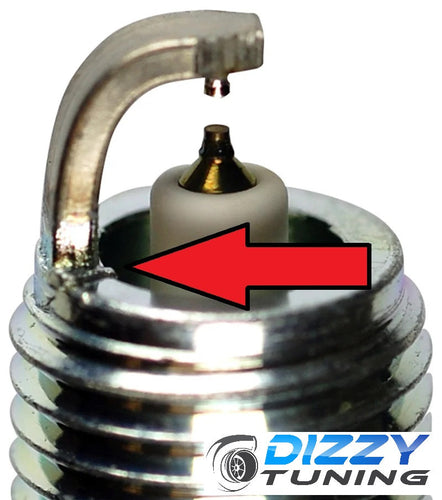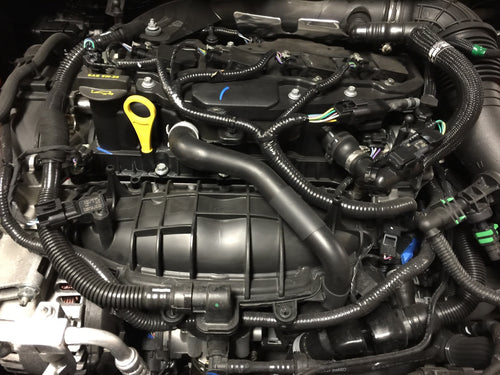
Fiesta ST - What is a MAP/TMAP Sensor?
- on April 16, 2020
- Categories: Tech Articles
I have been doing a lot of testing with aftermarket MAP/TMAP sensors lately, so I thought it was a good time to add another entry to the blog. In this entry, I will discuss the OEM MAP/TMAP configuration on the Fiesta ST 1.6L Ecoboost engine. Stay tuned for following entries where I will discuss the aftermarket options available for both of these sensors, and how we can use them to our benefit.
Before I explain the function of the MAP sensor, let’s first discuss “Absolute Pressure”, as that is how these sensors are designed to read. Absolute Pressure is the pressure relative to “Absolute” zero. Typical atmospheric pressure (near sea level) is 14.5-14.7 psi. So if we wanted to read down to zero, we would be reading below atmospheric pressure, or “vacuum”. When speaking of MAP sensors, or of “Absolute Pressure”, we cannot think of “zero” meaning atmospheric pressure (14.7 psi). This is commonly referenced as “PSIa” (absolute), where as “PSIg” is actual “gauge” pressure. For example: at Key On Engine Off (KOEO) the “MAP” monitor will read atmospheric pressure (PSIa), and the “Boost” monitor will read gauge pressure (0 psi)(PSIg). Another thing to note here is you may see some monitors on the AccessPort labeled “Abs.” and “Rel.”. This is referencing the pressure to “Absolute” or “Relative to atmosphere”.
A MAP (or Manifold Absolute Pressure) sensor is designed to read Absolute Pressure inside the intake manifold of an engine. Knowing the information we learned above, we know that vacuum is 0 psi, and atmospheric pressure is ~14.7 psi, then any pressure read above atmospheric would be a positive pressure reading. Most automotive map sensors operate in this manner, so when a manufacture claims a map sensor is a “3 bar” map sensor, that is the full range of the sensor. 1 bar negative (vacuum), and 2 bar positive (29.xx psi). For those unfamiliar, 1 bar of pressure equals 14.5038 psi.
Like most automotive sensors, the MAP sensor is a 5v sensor, that receives a power, ground, and has a signal output to the ECU. This signal output typically ranges from .5v to 4.5v. When 0 psi (Absolute) is read on the sensor, the signal output would be .5v. If a full 2 bars is read on the sensor, the output would be the max 4.5v. The MAP sensor output is a linear scale meaning that knowing Pressure 1 reference and Pressure 2 reference (aka P1 and P2), we can solve the equation y=m(x)+b to achieve the proper calibration for the sensor in question. We will discuss this more in my next entry about aftermarket sensors.
The Fiesta ST 1.6L Ecoboost uses two map sensors on the engine. One of them is actually not even on the intake manifold. It is located on the cold pipe, before the throttle body. This sensor is commonly called the TMAP Sensor, as it reads air temperature as well as pressure. The pressure that is read here at the cold pipe can be monitored as “TIP (Throttle Inlet Pressure) Actual”. This sensor’s main function is to make sure that pre-throttle pressures are not exceeded higher than the values set in the ECU. If these values are exceeded, you can experience partial (or sometimes very abrupt) throttle closures. This sensor can play an important role in tuning and safety, as you can control the amount of boost pressure, before it enters the intake manifold.
The other MAP sensor is located on the intake manifold. This sensor is reading pressure after the throttle plate, and can be monitored as “Boost” on your AccessPort. Since this sensor is located after the throttle plate, there will be vacuum present at times, hence the reason for the sensor’s ability to read down to 0 psi Absolute. The MAP sensor’s function is crucial for fueling the 1.6L Ecoboost engine. Simplified Speed Density (SD) logic, is that the ECU needs to determine the amount of air mass entering the engine in order to inject the correct amount of fuel. Air mass is calculated by the ECU using the MAP sensor, and various other barometric and temperature compensations. So it is very important that this sensor be in good condition, and there are no loose or intermittent connections, as it could fuel the engine incorrectly, or cause poor drivability. Both sensors are a “3 bar” range from the factory, meaning they both read 1 bar of vacuum, and 2 bar (or 29.xx psi) of positive pressure.
Thanks for reading, and please stay tuned for future entries where I will discuss the aftermarket options available for both of these sensors, and how we can use them to our benefit.








